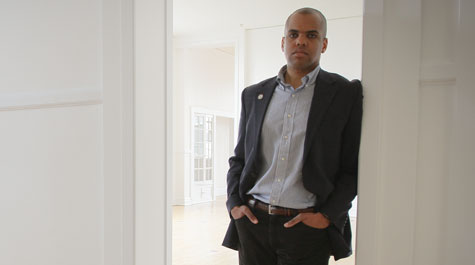Healing history: Justin Reid’s homeward journey
This story originally appeared in the spring 2013 issue of the W&M Alumni Magazine. - Ed.
Justin Reid ’09 leaned forward as he spoke in the old auditorium where, 61 years earlier, the students of Robert Russa Moton High School in Farmville, Va., decided to walk out in protest.
“This school, which was built for 180 students, had almost 500,” he said. “They didn’t have science laboratories; they didn’t have a cafeteria. They were having makeshift classes in tar paper shacks. ... So 450 students, some of them as young as 12 years old, decided they’d had enough.”
Today, the modest brick building houses the Moton Museum, where Reid works as associate director of museum operations.
A National Historic Landmark since 1998, it remains one of the most important sites of the modern civil rights struggle. It is also one of the least known — as Reid can attest, having learned little about it while growing up just a few miles away.
He is part of a small but determined team working to change that, and in a way that unites, rather than divides his hometown.
“We’re a community still wrestling with, and coming to terms with, our role in history,” Reid reflected. “Our battle wounds are still deep, and very real, and four decades of concealment and relative silence haven’t helped us heal. The Moton Museum is inspiring a new movement of collaboration, openness and honesty. That’s a movement I want to be a part of.”
The two-week boycott that the students launched on April 23, 1951, landed the all-black school at the center of the national firestorm over school segregation. NAACP lawyers filed a lawsuit on the students’ behalf that, three years later, became one of the five cases decided in Brown v. Board of Education, the U.S. Supreme Court’s landmark ruling against school segregation.
Virginia’s Prince Edward County responded in the extreme, closing its entire school system in 1959. The Supreme Court forced the schools’ reopening in 1964, but nothing could restore five years of public education lost to thousands of students.
The Moton Museum, Reid explained, honors both the county’s “walk-out” and “lock-out” generations. The museum is unveiling six new galleries this spring to tell their stories.
Last November, Reid returned to William & Mary with three lock-out generation members to give an oral history presentation at Swem Library. More than 100 people, including College President Taylor Reveley, attended.
Reid was both nervous and excited about bringing his work to the College. “It was really at William & Mary that I became conscious of what had happened in [Prince Edward County].”
He had enrolled as an undergraduate, he said, “pining for a career that would take me around the world.” He started early, working in Tanzania over two winter breaks and spending a summer in South Africa.
Planning on a career in the Foreign Service, he declared his major in international relations. But he also began taking American studies courses “for fun,” and wound up on a collision course with his hometown’s history and that of his own family.
When Prince Edward County’s story surfaced in classes about civil rights and constitutional law, Reid began asking more questions. He soon learned about his own relatives’ decisions to leave the county because of the school’s lockout, and about the close friendship between his great-uncle Warren “Kaiser” Reid and Rev. L. Francis Griffin. A local civil rights leader, Griffin filed the lawsuit that forced the county’s schools to reopen in 1964.
Griffin is among those honored on the Virginia Civil Rights Memorial in Richmond, Va. Reid attended the memorial’s dedication in 2008 before spending the summer studying in South Africa. It was an experience that, ironically, compelled him to look homeward even more.
“Here I was in post-apartheid South Africa, learning about the work being done there in terms of reconciliation and really coming to terms with history,” he said. “This was something that I realized my own community was just starting to grapple with.”
When he returned, he switched majors to American studies. “I slowly began to realize the things I cared about most — cultural sustainability and identity, community development, education — were things I could build a career around here, in my home community.”
Reid joined the Moton Museum as special projects manager in 2011 and became associate director for museum operations last year. His duties are a daily changing mix of outreach, programming and event hosting.
Working at the museum, he said, has helped him to understand why his community has remained largely mum about its past. “There was so much hurt wrapped up in that history, you just didn’t talk about it.”
He and his colleagues are trying to frame that conversation in a way that encourages participation from all sides. “We say that this is not a black history museum,” he said. “We view ourselves as an American history museum.”
 Skip to main content
Skip to main content

